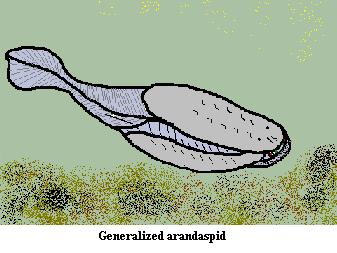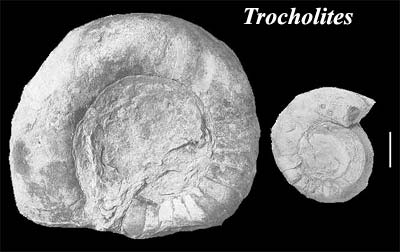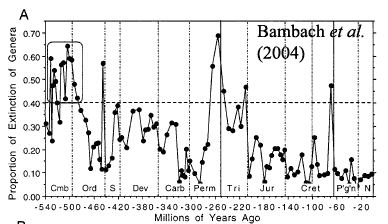
| Early Ordovician Epoch | ||
| PaleozoicOrdovician period | Floian Age Early Arenig) |
| Tremadoc | Furongian | Early Ordovician | ||
| Dapingian | Middle Ordovician | Time |
| Paleozoic Era Cambrian Period Terrenuevan Epoch Cambrian Epoch 2 Cambrian Epoch 3 (Middle Cambrian) Furongian Epoch (Late Cambrian) Ordovician Period Early Ordovician Epoch Tremadocian Age Floian Age (Early Arenig) Middle Ordovician Epoch Dapingian Age (Middle Arenig) Darriwilian Age (Late Arenig & Llanvirn) Late Ordovician Epoch Silurian Period Devonian Period Carboniferous Period Permian Period |
Credits: Thanks to Andreas Johansson for correcting some errors in Swedish spelling and word-use.
The second half of the Early Ordovician is now named the Floian. In Britain and various other systems, it was previously known as the Arenig, from the Welsh locality of that name. The Arenig was part of the original Ordovician System, and so it had a strong claim to historical priority. Moreover, everyone agreed on the stratigraphic level at which the Arenig began -- with the appearance of an easily-recognized group of graptolites. The problems were at the other end. First, careful dating showed that the Arenig, as that stage name had been used in Britain, lasted well into Middle Ordovician. Second, in other locations, the Arenig referred to a stage with a different end-point. Finally, even this general agreement had no close parallels in the North American or Western European systems, both of which have nothing comparable to the Arenig.
Consequently, the ICS chose to start over again. Although we are unhappy with that choice, the reasoning is so sound that we are forced to follow the logic of it. The problem is that there is almost nothing like the sound of Welsh It is one of a handful of languages that are inherently good to hear, even without understanding. And, as peculiar as it may seem, one of the great attractions of geology has always been the romance of its place names. Admit it. Would you really have developed an interest in the subject without names like East Gondwana, the Old Red Continent, the Maotianshan Shale, the Tethys Seaway, or the Deccan Traps? In the long run, the poetry of the Ordovician stage designations (some of the very first geological ages to be given names) has been more important to geology than the meaningless fourth decimal place of their radiometric dates. But the ICS has no poets, and so the Arenig, Llanvirn, Llandeilo, and Caradoc are all gone -- replaced by stratigraphic elevator music, like the names of suburban subdivisions or of clinics which cater to the more fashionable mental disorders.
However, rather than burst into an aggressive rendition of Men of Harlech, we will go with the flow -- literally in this case, as the base of the Floian is the first occurrence of the graptolite Tetragraptus approximatus in the Diabasbrottet (= "diabase quarry"), located near the town of Flo, about 15 km east of Trollhättan, in southwest Sweden [2]. Bergstrom et al. (2004). The quarry is actually located on "Mount" Hunneberg, one of two flat-topped hills famous for their particularly dense population of moose -- although, in our experience, moose tend to be rather dense just about anywhere.
 The Floian began with a rapid rise in sea level (a "marine transgression") world-wide. For this reason, the bottom of the Floian is often quite easy to find. If one locates a place of approximately the right age, where terrestrial or wind-scoured deposits have been overlain with marine sediments containing the distinctive Tetragraptus, chances are very good that you have located the base of the Floian.
The Floian began with a rapid rise in sea level (a "marine transgression") world-wide. For this reason, the bottom of the Floian is often quite easy to find. If one locates a place of approximately the right age, where terrestrial or wind-scoured deposits have been overlain with marine sediments containing the distinctive Tetragraptus, chances are very good that you have located the base of the Floian.
This transgression was peculiar in that it is associated with a strong, negative δ13C excursion of 2‰ and, at least in North America, the deposition of a thin micritic layer. Nice jargon, but what does it mean? Carbon has two stable isotopes, 12C and 13C, with the latter having one extra neutron in the nucleus. In theory, one neutron more or less should make absolutely no difference to the chemical behavior of the carbon atom. In practice, this is almost true, but not quite. Photosynthesis by plants and "blue-green algae" (photosynthetic bacteria) incorporates atmospheric CO2 into sugars. For obscure reasons, photosynthesis tends to pick up a slightly larger fraction of light carbon (12C) than it "should" by chance alone. Biological reactions can tie up immense amounts of carbon. When lots of atmospheric carbon gets tied up in biological products and is not recycled -- which can happen for a variety of reasons -- the isotope ratio in the atmosphere gets skewed toward the "heavy" 13C isotope. So, photosynthetic organisms living at that time pick up a greater than normal fraction of 13C. That's called a positive δ13C excursion and can be detected in fossils by isotope analysis. The opposite, a negative excursion, happens when lots of stored biological carbon is suddenly recycled, such as by the burning of fossil fuels.
 So why do we see a strong negative excursion at the base of the Arenig? We can be reasonably sure that Ordovician brachiopods did not drive SUVs. One of the many advantages of being sessile is the elimination of all traffic congestion. The clue may be the "micritic layer." This betokens biofilms formed by sulfate reducing bacteria. These bacteria normally work in tandem with methane-eating bacteria, like so:
So why do we see a strong negative excursion at the base of the Arenig? We can be reasonably sure that Ordovician brachiopods did not drive SUVs. One of the many advantages of being sessile is the elimination of all traffic congestion. The clue may be the "micritic layer." This betokens biofilms formed by sulfate reducing bacteria. These bacteria normally work in tandem with methane-eating bacteria, like so:
CH4 + 2 H2O ■─> CO2 + 4 H2
methane oxidized to carbon dioxide and hydrogen gas
SO42- + 4 H2 + H+ ■─> HS- + 4 H2O sulfate reduced to sulfide and water
This reaction is sometimes driven by iron II (Fe2+), which not only catalyzes some the key steps, but tends to remove the sulfide at the end as insoluble FeS (pyrite). Schouten et al. (2003); Madigan et al. (2003).
The key fact here is that natural releases of methane tend to be very "light." An increase in atmospheric methane would dilute the "heavy" carbon in the atmosphere after the methane was converted to carbon dioxide by these bacteria. So the entire mystery may be solved by invoking methane release, probably associated with the sea floor spreading ridges which presumably created the sea level rise in the first place. This is all quite similar to the developing picture of certain events in the Aptian-Albian epoch of Cretaceous time.

The Floian has recently been identified as a statistical breakpoint for metazoan evolution. Bambach et al. (2004). Prior to the Floian, genus-level turnover was extraordinarily high, and the entire metazoan tree looks unstable, with large taxa frequently experiencing random-looking booms and busts. During the Floian and Middle Ordovician, extinction rates dropped sharply and remained far lower than in Cambrian and Tremadoc times; and they remained lower, except for the three actual mass extinctions of Phanerozoic time. These generalizations depend on a kind of data that may rightly be viewed with some suspicion. However, the trend line seems safe enough. Whatever genus one might be, one's life expectancy began to go up dramatically over the Floian.
ATW041127. Text public domain. No rights reserved.
ATW041127.